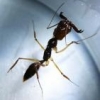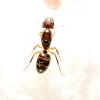Found: Children's park in Rocky Mount, North Carolina
Date: February 11, 2017
Habitat: Found roaming around in the driveway of a neighborhood park near a large line of trees
Length: 6.25mm (head to tip of gaster)
Coloration: Brown thorax, head, and gaster. Legs are a lighter brown and lines on the gaster are also lighter brown. Has a good amount of hair all over.
Distinguishing Characteristics: 1 Petiole node, 2 antennal segments.
Edited by dspdrew, February 11 2017 - 11:44 PM.
Fixed images





















